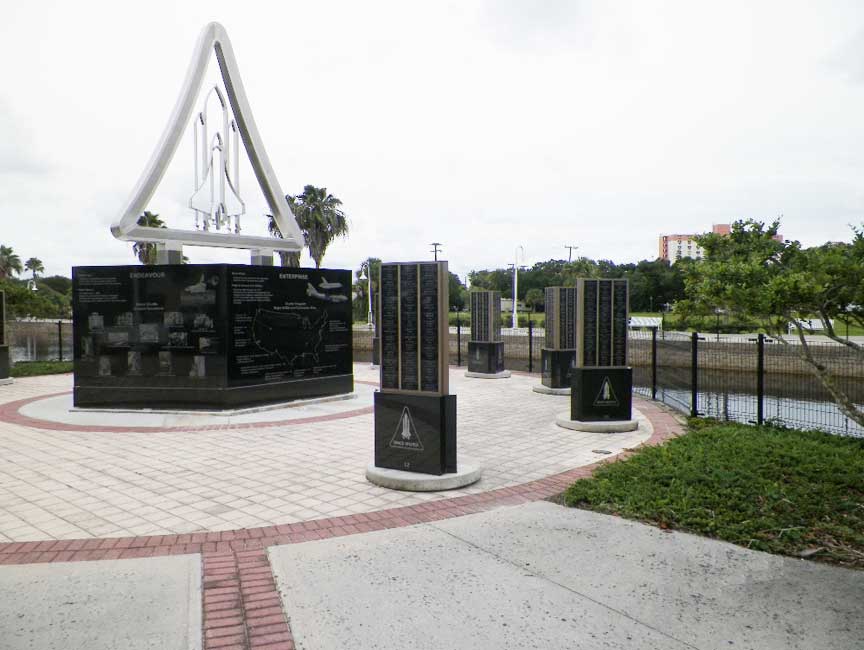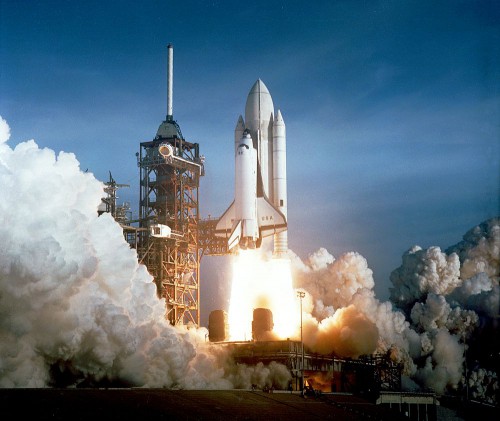
This past Saturday morning, on Nov. 1, various space luminaries, shuttle astronauts, members of the Brevard County community, former space shuttle program workers, and local citizens paid tribute to the space shuttle era as the Space Walk of Fame Museum, located in Titusville, Fla., dedicated its new shuttle monument at Space View Park. This monument is adjacent to other tributes memorializing Mercury, Gemini, and Apollo. In a Florida Today article written by Rick Neale, it was said the monument “ … cost about $350,000. Six black granite panels on the 8-foot-tall base display information on shuttle processing, ground operations, missions and major NASA and space contractor sites.”
On April 12, 1981, twenty years after human spaceflight began with Yuri Gagarin’s Vostok 1 mission, an exciting new era of spaceflight began: A reusable orbiter named Columbia, bolted to two reusable solid rocket boosters and a disposable white external tank (orange after STS-2), lifted off for the first time from Kennedy Space Center’s Launch Complex 39A. It was perhaps spaceflight’s riskiest “test flight.”
Crewed by Gemini/Apollo veteran commander John W. Young and then-rookie pilot Bob Crippen, 12 years of development would give way to 30 years of exploration, including the deployment of iconic payloads (such as the Hubble Space Telescope, still at work today after nearly 25 years of operation), meeting up with a Russian space station (Shuttle-Mir), building the International Space Station, and innumerable other accomplishments bringing many nations together in low-Earth orbit.
According to Florida Today, first space shuttle pilot Bob Crippen shared his thoughts at the dedication. A veteran of four shuttle fights from 1981 to 1984 and known as “Mr. Shuttle,” Crippen discussed the “never give up” attitude of the thousands of workers and personnel attached to the program, which aided in its rebound after two tragedies (Challenger’s destruction post-launch in 1986, and Columbia’s breakup upon reentry in 2003). “When I look back on the program, it was a great experience. Yes, we had two terrible tragedies. But every time it happened, the program picked itself up by its bootstraps and got the program back flying again — and flying safely,” Crippen related.

He added, “When my daughter called from Houston and told me that we had lost contact with Columbia, I knew that that was probably going to be the demise of the program. But truthfully, I never expected the shuttle would be canceled without some other way of putting our crews up in space here from the United States. But that’s what’s happened. And we can look back and remember the program fondly.”
Astronaut Jon McBride, also quoted in the Florida Today article, underscored the contributions of the thousands of workers responsible for putting together the hardware associated with shuttle missions. Many of these workers spoke at the dedication, sharing their accomplishments that contributed to the success of the shuttle program.
“We get a lot of the credit, a lot of the glory for going up there in space, get to meet the presidents and all the other people and things like that. But we couldn’t have done anything we have done, had it not been for all those we stood up and spoke to us — and all the others who couldn’t be with us today. God bless them,” McBride related.
This monument dedication was a bright spot in a week of setbacks in spaceflight. On Tuesday, Oct. 28, an Antares launch vehicle carrying a Cygnus cargo spacecraft was destroyed shortly after launch at NASA’s Wallops Flight Facility in Wallops Island, Va.; on Friday, Oct. 31, Virgin Galactic’s SpaceShipTwo broke up shortly after igniting its engines over California’s Mojave Desert.
It should be noted that while the space shuttle program suffered its own setbacks (some before the shuttle ever flew), it returned triumphantly. The shuttle program, even three years after its conclusion, still sets the example for a newer generation of space engineers, workers, and future space travelers and people who look up at the skies.
Want to keep up-to-date with all things space? Be sure to “Like” AmericaSpace on Facebook and follow us on Twitter: @AmericaSpace




STS-1 had a white colored ET Tank.
Gah! You are correct sir. Sorry about that oversight, it is corrected.
On the first two missions, STS-1 and STS-2, the external tanks were painted white to protect them from ultraviolet light during the extended time that the shuttle spends on the launch pad prior to launch. Because this did not turn out to be a problem, Martin Marietta reduced weight by ceasing to paint the external tanks beginning with STS-3, leaving the rust-colored spray-on insulation bare, saving approximately 272 kg (600 lb).